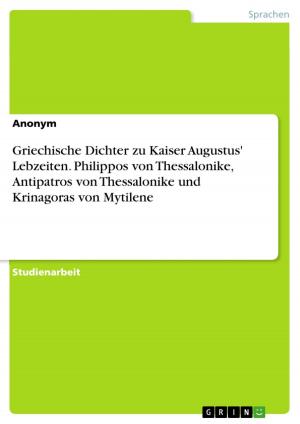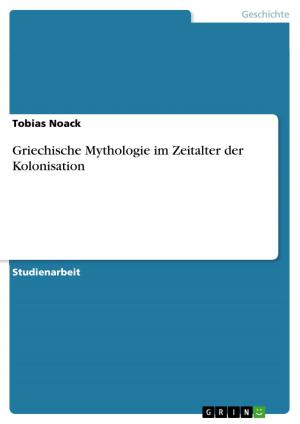| Author: | Daniel Roth | ISBN: | 9783656131236 |
| Publisher: | GRIN Verlag | Publication: | February 15, 2012 |
| Imprint: | GRIN Verlag | Language: | English |
| Author: | Daniel Roth |
| ISBN: | 9783656131236 |
| Publisher: | GRIN Verlag |
| Publication: | February 15, 2012 |
| Imprint: | GRIN Verlag |
| Language: | English |
Seminar paper from the year 2009 in the subject English Language and Literature Studies - Literature, grade: 1,0, University of Trier, course: The American Films of Alfred Hitchcock, language: English, abstract: 1. Introduction It was probably Psycho´s expressionistic interplay between music, mise en scène and story telling which remotely reminded me of Martin Scorsese´s Taxi Driver, a film I had written about before, that fostered my decision to write about the film that is by many considered to be Alfred Hitchcock´s masterpiece. As a student of English literature I became quickly interested in the literary model of Psycho by Robert Bloch. It soon dawned on me that since the book is basically a piece of pulp fiction with considerably low literary value I would not be able to draw very profound interpretations out of it. Hitchcock however had not adapted the book for its substance but for its structure which he had incorporated with some minor alterations almost identically into the film. On my search for the structure of my paper a book by Vibeke Reuter called Alfred Hitchcocks Handschrift rose my attention. Her starting point basically is the question what constituted Hitchcock´s originality and in how far his filmic material differs from its literary models. With occasional references to the books she analyzes Hitchcock´s films according to ten different narrative parameters. These parameters cover a broad range of aspects and in terms of narration display a rather integral picture. I adopted her structure but omitted the parameter of the 'structure of time' since Hitchcock pretty much conformed with the novel`s chronology and the fact that some characters are in a way imprisoned by their past did not prove to be enough to form a whole subsection. As far as she referred to Psycho in her book I have integrated her arguments into my own argumentation. Like her I have primarily concentrated on the 1960 film and only referred to the novel in order to elaborate on Hitchcock´s innovations or his fixations that were already laid out in the book. How he tells his version of the story, creates suspense and produces identificatory uneasyness shall be worked out. ................. Subsections: Introduction, Peculiarities (Begebenheiten), Heterosexual Relationships, Evil, Guilt, The Gaze, Psychological Ideas, The Picture of State Authorities, Structure, Narrative Situation, Distribution of Knowledge, Language, Motifs and Symbols, Geometrical Patterns, Mirrors, Birds, Space, Characters, Places of Indefinition (Unbestimmtheitsstellen), Elements of Genre, Conclusion, Sources, Internet Sources
Seminar paper from the year 2009 in the subject English Language and Literature Studies - Literature, grade: 1,0, University of Trier, course: The American Films of Alfred Hitchcock, language: English, abstract: 1. Introduction It was probably Psycho´s expressionistic interplay between music, mise en scène and story telling which remotely reminded me of Martin Scorsese´s Taxi Driver, a film I had written about before, that fostered my decision to write about the film that is by many considered to be Alfred Hitchcock´s masterpiece. As a student of English literature I became quickly interested in the literary model of Psycho by Robert Bloch. It soon dawned on me that since the book is basically a piece of pulp fiction with considerably low literary value I would not be able to draw very profound interpretations out of it. Hitchcock however had not adapted the book for its substance but for its structure which he had incorporated with some minor alterations almost identically into the film. On my search for the structure of my paper a book by Vibeke Reuter called Alfred Hitchcocks Handschrift rose my attention. Her starting point basically is the question what constituted Hitchcock´s originality and in how far his filmic material differs from its literary models. With occasional references to the books she analyzes Hitchcock´s films according to ten different narrative parameters. These parameters cover a broad range of aspects and in terms of narration display a rather integral picture. I adopted her structure but omitted the parameter of the 'structure of time' since Hitchcock pretty much conformed with the novel`s chronology and the fact that some characters are in a way imprisoned by their past did not prove to be enough to form a whole subsection. As far as she referred to Psycho in her book I have integrated her arguments into my own argumentation. Like her I have primarily concentrated on the 1960 film and only referred to the novel in order to elaborate on Hitchcock´s innovations or his fixations that were already laid out in the book. How he tells his version of the story, creates suspense and produces identificatory uneasyness shall be worked out. ................. Subsections: Introduction, Peculiarities (Begebenheiten), Heterosexual Relationships, Evil, Guilt, The Gaze, Psychological Ideas, The Picture of State Authorities, Structure, Narrative Situation, Distribution of Knowledge, Language, Motifs and Symbols, Geometrical Patterns, Mirrors, Birds, Space, Characters, Places of Indefinition (Unbestimmtheitsstellen), Elements of Genre, Conclusion, Sources, Internet Sources















